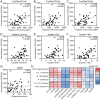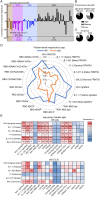This is a preprint.
BNT162b2 induced neutralizing and non-neutralizing antibody functions against SARSCoV-2 diminish with age
- PMID: 36032979
- PMCID: PMC9413715
- DOI: 10.1101/2022.08.12.22278726
BNT162b2 induced neutralizing and non-neutralizing antibody functions against SARSCoV-2 diminish with age
Update in
-
BNT162b2-induced neutralizing and non-neutralizing antibody functions against SARS-CoV-2 diminish with age.Cell Rep. 2022 Oct 25;41(4):111544. doi: 10.1016/j.celrep.2022.111544. Epub 2022 Oct 5. Cell Rep. 2022. PMID: 36252569 Free PMC article.
Abstract
Each novel SARS-CoV-2 variant renews concerns about decreased vaccine efficacy caused by evasion of vaccine induced neutralizing antibodies. However, accumulating epidemiological data show that while vaccine prevention of infection varies, protection from severe disease and death remains high. Thus, immune responses beyond neutralization could contribute to vaccine efficacy. Polyclonal antibodies function through their Fab domains that neutralize virus directly, and Fc domains that induce non-neutralizing host responses via engagement of Fc receptors on immune cells. To understand how vaccine induced neutralizing and non-neutralizing activities synergize to promote protection, we leverage sera from 51 SARS-CoV-2 uninfected health-care workers after two doses of the BNT162b2 mRNA vaccine. We show that BNT162b2 elicits antibodies that neutralize clinical isolates of wildtype and five variants of SARS-CoV-2, including Omicron BA.2, and, critically, induce Fc effector functions. FcγRIIIa/CD16 activity is linked to neutralizing activity and associated with post-translational afucosylation and sialylation of vaccine specific antibodies. Further, neutralizing and non-neutralizing functions diminish with age, with limited polyfunctional breadth, magnitude and coordination observed in those ≥65 years old compared to <65. Thus, studying Fc functions in addition to Fab mediated neutralization provides greater insight into vaccine efficacy for vulnerable populations such as the elderly against SARS-CoV-2 and novel variants.
Figures





Similar articles
-
BNT162b2-induced neutralizing and non-neutralizing antibody functions against SARS-CoV-2 diminish with age.Cell Rep. 2022 Oct 25;41(4):111544. doi: 10.1016/j.celrep.2022.111544. Epub 2022 Oct 5. Cell Rep. 2022. PMID: 36252569 Free PMC article.
-
Loss of Pfizer (BNT162b2) Vaccine-Induced Antibody Responses against the SARS-CoV-2 Omicron Variant in Adolescents and Adults.J Virol. 2022 Sep 14;96(17):e0058222. doi: 10.1128/jvi.00582-22. Epub 2022 Aug 17. J Virol. 2022. PMID: 35976000 Free PMC article.
-
Reduced neutralization and Fc effector function to Omicron subvariants in sera from SARS-CoV-1 survivors after two doses of CoronaVac plus one dose subunit vaccine.J Med Virol. 2023 Oct;95(10):e29136. doi: 10.1002/jmv.29136. J Med Virol. 2023. PMID: 37804496
-
Assessment of Neutralizing Antibody Response Against SARS-CoV-2 Variants After 2 to 3 Doses of the BNT162b2 mRNA COVID-19 Vaccine.JAMA Netw Open. 2022 May 2;5(5):e2210780. doi: 10.1001/jamanetworkopen.2022.10780. JAMA Netw Open. 2022. PMID: 35532938 Free PMC article.
-
Beyond neutralization: Fc-dependent antibody effector functions in SARS-CoV-2 infection.Nat Rev Immunol. 2023 Jun;23(6):381-396. doi: 10.1038/s41577-022-00813-1. Epub 2022 Dec 19. Nat Rev Immunol. 2023. PMID: 36536068 Free PMC article. Review.
Cited by
-
Mutant LRRK2 exacerbates immune response and neurodegeneration in a chronic model of experimental colitis.Acta Neuropathol. 2023 Aug;146(2):245-261. doi: 10.1007/s00401-023-02595-9. Epub 2023 Jun 8. Acta Neuropathol. 2023. PMID: 37289222 Free PMC article.
References
Publication types
Grants and funding
LinkOut - more resources
Full Text Sources
Miscellaneous
